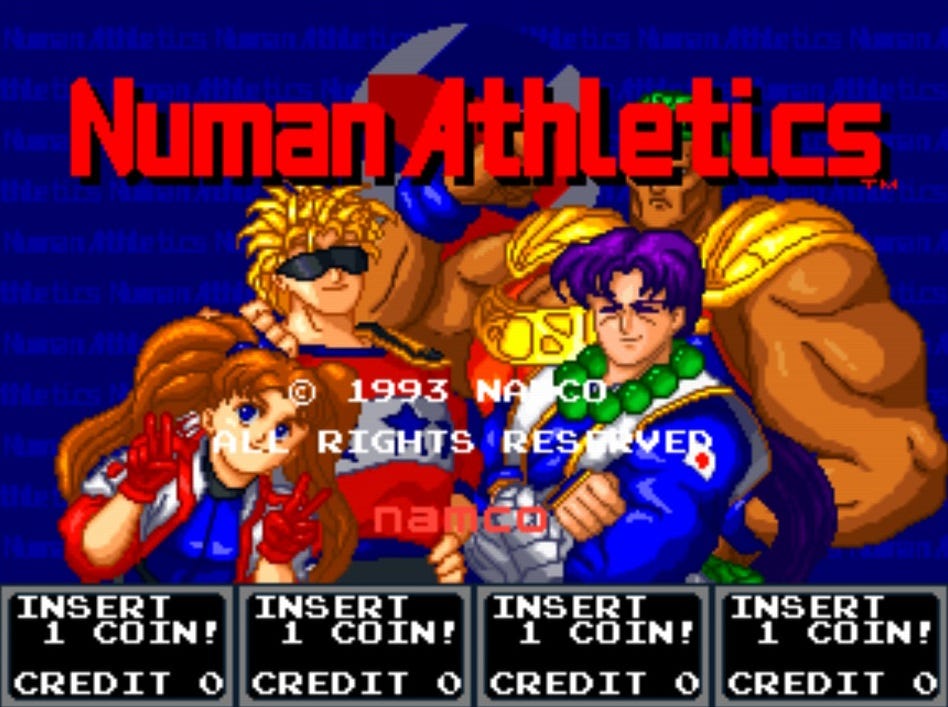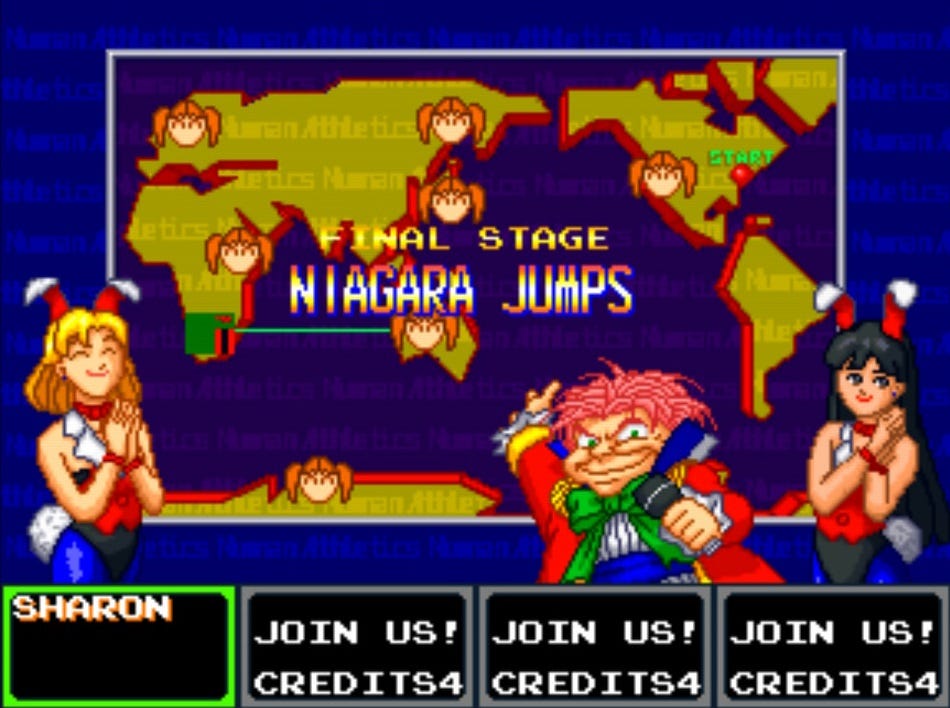Past meets present: Numan Athletics
Namco's wild take on track and field involves scaling buildings and throwing missiles and shooting monsters. Also, it rules.
This column is “Past meets present,” the aim of which is to look back at game franchises and games that are in the news and topical again thanks to a sequel, a remaster, a re-release, and so on. Previous entries in this series can be found through this link.
Arcade Archives is a wonderful service for a number of reasons. There are obvious ones, like how the arcade version of a whole bunch of classic games converted to consoles were superior in their original forms — which were oftentimes on more powerful hardware. A favorite of mine, though, is the games that sometimes show up on the service that were never going to get those home conversions, even if they were popular. They were made for the arcade, with the arcade in mind, and couldn’t easily be translated over into a $50 or $60 or however many dollars cartridge or CD-ROM. At least, not in a way that would have resulted in any decision maker being happy about what happened next, at least.
Numan Athletics is one such game. It’s a track and field-style sports title, released in 1993 on Namco’s NA-2 board, that’s at its best when you can compete against up to three others. Given every home console required a multitap back then to have more than two players, that right there would have limited the potential of the game for most people, or at least capped it at a lesser version of itself. In addition, it’s rapid-paced with a high failure rate, and designed to eat quarters, sure, but designed for you to want to keep feeding it those quarters. Numan Athletics is short, but not in the way a shooting game is, where it’s only short once you’ve figured out, after a whole lot of failure spread out over hours and hours, how exactly to proceed in a way that lets you even get to the end of it. It might take you some time to master Numan Athletics, but getting through the events is as simple as continuing to insert quarters after you’ve failed, and trying again without losing progress. You don’t actually even need to succeed to proceed, considering all it takes is one of the players managing it for everyone to move on. Losing players because they ran out of continues in a home port might have taken something away from the proceedings, considering you’re competing against yourself and others more than the game. Winning is fun and all, but you’d like to win after seeing all of the various events and completing the competition that way.
Anyway, whether Numan Athletics could have succeeded as a home conversion is besides the point. It didn’t get one, and has been mostly lost to time since leaving arcades — Namco’s support of Nintendo’s Virtual Console adding classic arcade games didn’t always extend to North America, with Numan Athletics only getting a release on Japan’s storefront. In the spring of 2024, however, Hamster added it to the Arcade Archives service on Switch and Playstation 4, and did so worldwide, giving it the first such home release in its over 30-year existence. Would we ever see such a release without Arcade Archives? Consider how many Namco Museums iterations there have been since the series originated on the original Playstation: that’s the same number of Namco Museum releases that didn’t have Numan Athletics included.
Part of all of this is the sheer oddity of the game. It’s not a straight track and field representation, with real-life events. Instead, look to the title for an idea of what’s inside: “Numan” is used to describe mutant humans with super strength, speed, agility, and also the ability to fire laser beams out of their hands. It’s basically the Superhuman Olympics, except even more so than the actual Olympics are. Hey, the feats of strength and skill in the Olympics are something else, but I don’t see any of those athletes stopping a bullet train with their bare hands before throwing it back the width of a soccer field in the other direction.
I’m not just going to drop that info without showing you the actual act, either, come on:
That’s Sharon, the Numan representative from France and the character locked to the first player slot, stopping a train with the press of one button by you — the middle of three — and then alternating button presses of the outside ones to build up power. After a certain amount of time goes by, the train is thrown backwards relative to how much power was built up in those presses. To advance, in the first go, you must clear the world record, which in this case was a 58-meter push. You get two chances in this particular event to pull it off — the first one here was 49 meters, which, if it had held as the top effort, would have resulted in failure, and the need to add another credit to continue.
If you play solo, all you need to do is eventually succeed, and you can move on. The bar for success ends up being lowered with each successive attempt at an event: at first, you need to go for the world record to advance, but after that, a few meters or seconds will be dropped from the expectations, and you’ll have an easier time of things. You can still break the world records after failing, mind you, it’s just that they’re no longer the threshold that you’re required to reach in order to move on. These rules all apply to multiplayer, as well, except all it takes to move on there is one player making it. They’ll be awarded the most points for their successful completion of the event, while those who failed will… well, not. They’ll also need to add another credit to continue on. Luckily, the events vary enough that success in one does not guarantee success in another. The next round might see the previous victor on the wrong side of things, helping to even things back up and keep the game competitive in the process.
In addition to stopping the train — that event is called “Vs. Express” — there are seven other to compete in. Missile Toss has you running with a missile in your hands, alternating outside button presses to run as fast as you can — over 200 mph if you do it right — before stopping on a dime and throwing the missile with the middle button. If you stop too late, you go for a swim and are scored with a Fault. Quit running too early, and you won’t throw the missile nearly far enough. Nonstop Rock Chop also has you using the first and third buttons in alternating presses to build up, in this case, power: you have to smash rocks with your hands as quickly as possible, most rocks smashed wins. Niagara Jumps, the final event, uses a similar system to Missile Toss, except instead of stopping to throw when you finish running, you jump right into the middle of Niagara Falls, and then jump once more, and once again: the winner is the one who made it the furthest on the other side of the waterfall, the losers those who didn’t make it as far, or didn’t make it at all, because they fell into the water screwing up the continuous jump timing. The most straightforward event in the whole game, and which also uses alternating button presses, is Turbo Dash, which is a 100-meter dash with all athletes competing at the same time. There’s no second thing you need to be mindful of here, so get slamming those buttons faster and at a better rhythm than your friends.
Not all of the events use this alternating button pressing setup. Interceptor has you using the buttons for positioning — the left button has you go left, the right to the right, and the middle is for shooting. A military ship is out on the water, firing cannons at the port where you’re standing, and you have to, as the name of the game says, intercept those shots with your own return fire. Miss once, and you fail. Numan Sniper has a similarish concept, except it has all the Numans competing simultaneously, and instead of stopping cannon blasts, enormous monsters are rising up from the water: this one is a race not only against the other athletes to attack first, but also to react as quickly as possible to score the most points. Get the monster at practically the moment is comes out of the water, and score 2,500 points. Have even a slight delay that still might seem like a quick reaction to you, and the score you’ll earn will drop precipitously.
Tower Topper has you using just one button, the middle one, to jump in the most efficient way possible. You’re basically doing a nonstop series of wall jumps to climb to the destination, but the jumps need to be longer ones in order to ascend the entire structure in record time, which is only possible by waiting long enough to get the angle for higher jumps. Wait too long, and the energy seen under your athlete will dissipate, and you’ll fall and lose. Impatience will cost you time, which will bring you the same result in the end.
Numan Athletics didn’t get a home conversion in the 90s, no, but it did get an arcade sequel, owing to its success in that space. Whereas the original was released worldwide in arcades, Mach Breaker, which launched in 1995, only came out in Japan. While Numan Athletics had just the four athletes and each was locked to a specific player space, Mach Breakers features seven possible competitors, and if there aren’t four human players present, the rest of the roster will be filled out by the appropriate number of them at random. That was really the only flaw Numan Athletics had, that playing solo was truly playing solo, but on the bright side, competing against the world records is still loads of fun. The thresholds for success in Numan Athletics only become low if you fail constantly and have to keep throwing quarters in there. Otherwise, it’s asking a lot of you, which is why each event gives you a demonstration beforehand so that you can see what’s expected of you instead of just assuming based on a quick written explanation.
As with everything else on Arcade Archives, you can pick up Numan Athletics for $7.99. And you should: it’s a lovely little series of challenges if you’re playing on your own, but with at least one other player, it transforms into one of the great arcade games and multiplayer offerings you’ll have in your library, one loaded with personality, color, and the soundtrack to go with all of that.
This newsletter is free for anyone to read, but if you’d like to support my ability to continue writing, you can become a Patreon supporter, or donate to my Ko-fi to fund future game coverage at Retro XP.





Wow, I've never heard of this. Where do you keep finding these games?